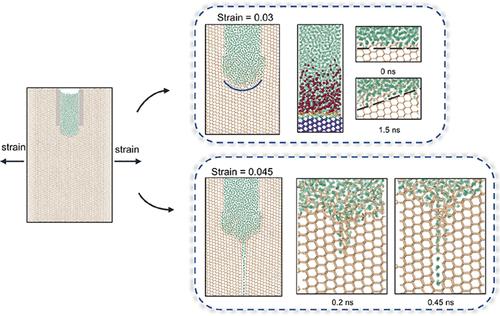硅阳极裂纹尖端应力驱动锂化的原子观研究
IF 8.2
2区 材料科学
Q1 MATERIALS SCIENCE, MULTIDISCIPLINARY
引用次数: 0
摘要
硅是下一代锂离子电池阳极的主要候选者,因为它具有很高的理论容量。然而,在锂化和脆化过程中,较大的体积变化会产生显著的机械应力,导致颗粒断裂和裂纹形成,从而降低电极性能。在这项工作中,我们使用由NEP框架训练的机器学习势驱动的分子动力学模拟,沿着[112]方向研究了裂缝尖端的锂化动力学。通过应用一系列拉伸应变,我们系统地探索了裂纹尖端应力场如何影响原子尺度的锂化过程。在零应力下,锂的插入过程均匀进行,形成扁平的非晶界面。中等拉伸应力导致阶梯状界面形态的形成,这符合边缘介导的非晶化机制。定量动力学分析表明,拉伸应变降低了锂化活化能,从而加速了界面扩展。在较高的应力水平下,锂化前缘变得不稳定,并通过狭窄的应力引导通道深入到晶体硅中。这些结果表明,机械应力场不仅调节了锂化动力学,而且还决定了反应前沿的形态演化。这项研究为控制硅中锂化行为的化学-机械耦合提供了基本的原子见解,并可能为更耐用的高容量电池电极的设计提供信息。本文章由计算机程序翻译,如有差异,请以英文原文为准。

Atomistic Insights into Stress-Driven Lithiation at Silicon Anode Crack Tips
Silicon is a leading candidate for next-generation lithium-ion battery anodes due to its high theoretical capacity. However, large volume changes during lithiation and delithiation generate significant mechanical stress, leading to particle fracture and crack formation, which degrade electrode performance. In this work, we investigate the lithiation dynamics at the tip of the crack along the [112̅] direction using molecular dynamics simulations driven by a machine learning potential trained with the NEP framework. By applying a range of tensile strains, we systematically explored how crack-tip stress fields influence the atomic-scale lithiation process. Under zero stress, lithium insertion proceeds uniformly, generating a flat amorphous–crystalline interface. Moderate tensile stress leads to the formation of a stepped interface morphology, which is consistent with a ledge-mediated amorphization mechanism. Quantitative kinetic analysis reveals that tensile strain reduces the activation energy for lithiation, thereby accelerating interface propagation. At higher stress levels, the lithiation front becomes unstable and advances via narrow, stress-guided channels that penetrate deeply into the crystalline silicon. These results demonstrate that mechanical stress fields not only modulate lithiation kinetics but also dictate the morphological evolution of the reaction front. This study provides fundamental atomistic insights into the chemo-mechanical coupling that governs lithiation behavior in silicon and may inform the design of more durable high-capacity battery electrodes.
求助全文
通过发布文献求助,成功后即可免费获取论文全文。
去求助
来源期刊

ACS Applied Materials & Interfaces
工程技术-材料科学:综合
CiteScore
16.00
自引率
6.30%
发文量
4978
审稿时长
1.8 months
期刊介绍:
ACS Applied Materials & Interfaces is a leading interdisciplinary journal that brings together chemists, engineers, physicists, and biologists to explore the development and utilization of newly-discovered materials and interfacial processes for specific applications. Our journal has experienced remarkable growth since its establishment in 2009, both in terms of the number of articles published and the impact of the research showcased. We are proud to foster a truly global community, with the majority of published articles originating from outside the United States, reflecting the rapid growth of applied research worldwide.
 求助内容:
求助内容: 应助结果提醒方式:
应助结果提醒方式:


